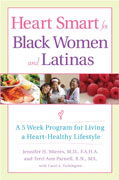In May, the American Heart Association’s campaign, Go Red for Women, released a report that ranks the top 10 heart-health-friendliest and-unfriendliest U.S. cities in which women live. By looking at the heart-friendly benefits cities have to offer and the personal lifestyle choices of its residents, they found that Minneapolis had the lowest rates of cardiac mortality and hypertension along with the highest exercise rates. Coming in last was Nashville, which had the highest obesity and smoking rates.
Most friendly:
- Minneapolis-St. Paul-Bloomington, MN
- Washington, DC
- San Francisco-San Jose-Oakland, CA
- Denver-Aurora, CO
- Boston-Cambridge-Quincy, MA
- Seattle-Tacoma-Bellevue, WA
- Portland-Vancouver-Beaverton, OR
- San Diego-Carlsbad-San Marcos, CA
- Los Angeles-Long Beach-Santa Ana, CA
- Phoenix-Mesa-Scottsdale, AZ
Least friendly:
- Nashville-Davidson-Murfreesboro, TN
- St. Louis, MO
- Detroit-Warren-Livonia, MI
- Pittsburgh, PA
- Dallas-Fort Worth-Arlington, TX
- Columbus, OH
- Cincinnati-Middletown, OH
- Las Vegas-Paradise, NV
- Cleveland-Elyria-Mentor, OH
- Indianapolis, IN
In addition to listing the cities, the study also stressed some sobering stats about cardiovascular disease (CVD) and black women:
- We are more likely to die of heart disease—heart attack, stroke and hypertension—than our white counterparts.
- High blood pressure is a leading cause of stroke and 46.6 percent of black women suffer from it.
- 79.6 percent of us are overweight or obese and 17.3 percent of us smoke nicotine—both increase the risk for heart attack and stroke.
So what can we do with all of this information? New York-based cardiologist and American Heart Association spokesperson Jennifer Mieres, MD, offers insights and suggestions on how to address the problem.
Real Health: Why are black women suffering from heart disease at such a disproportionate rate?
Jennifer Mieres, MD: African-American women are more likely to be obese and overweight—about 79.6 percent. Then there are other risk factors, such as hypertension and high blood pressure that affect black women at higher rates. In addition, diabetes and high cholesterol levels also play a factor. Whether heart disease is due to genetics or a history of physical inactivity, these are serious issues.
What can we do about it?
Americans need to know that simple lifestyle changes can result in big gains for controlling risk factors for heart disease. First, we have to be more active. I hope this campaign helps women understand that simple activities, such as walking, riding a bike, even dancing to music at home, can make a difference. You just have to move every day.
The second is changing your diet by eating healthier. And that can be done in little steps, just by leaving out salt and incorporating spices, such as Mrs. Dash, pepper and basil, among others, to get the same flavor without risking heart damage. Also, cook foods by grilling instead of frying.
I think the piece that is missing is having the knowledge. When women were polled, only 38 percent realized that heart disease was a force to be reckoned with.
Heart disease is the no. 1 killer of women, and not enough people know that. You have to know your numbers and if you don’t know then talk to your doctor. Go Red is committed to getting the facts straight and giving women life long strategies in hopes to decreasing their chances of developing heart disease.
The website Goredforwomen.org has great information–like the previously mentioned tips–to help all women in any community.
What are some of the difficulties in trying to urge people to make lifestyle changes?
Back in the day, people had to walk everywhere and do physical labor. Now, in the computer age, everybody drives, especially when you look at the least heart-friendly cities. People are just not active enough.
Start with a goal: walking 5,000 steps a day and then building yourself up to 10,000 steps. You can achieve that by parking your car a little farther in the lot. Of course, only do this if it’s safe.
(RH stresses the importance of buying a pedometer—a device that tracks the number of steps you take in a day—to help you reach your goal of 10,000 steps. Buy one here.)
Does living in a heart-friendly city mean that you are off the hook from getting heart disease?
No it doesn’t mean that. (Laughing) Just like women who live in a heart-health- unfriendly city should not be discouraged. This is about lifestyle, and you can make simple, everyday changes to make a difference in your heart health.  FYI: If you want to make some lifestyle changes but don’t know where to start, RH suggests reading Mieres’s book Heart Smart for Black Women and Latinas: A 5-Week Program for Living a Heart-Healthy Lifestyle to get started. It provides tips to start eating a heart-healthy diet, by learning what to eat and how to modify traditional recipes; begin an easy-to-follow exercise program and create ways to get the whole family involved. It also offers information on how women can best work with their doctor to take control of their heart’s health.
FYI: If you want to make some lifestyle changes but don’t know where to start, RH suggests reading Mieres’s book Heart Smart for Black Women and Latinas: A 5-Week Program for Living a Heart-Healthy Lifestyle to get started. It provides tips to start eating a heart-healthy diet, by learning what to eat and how to modify traditional recipes; begin an easy-to-follow exercise program and create ways to get the whole family involved. It also offers information on how women can best work with their doctor to take control of their heart’s health.






Comments
Comments